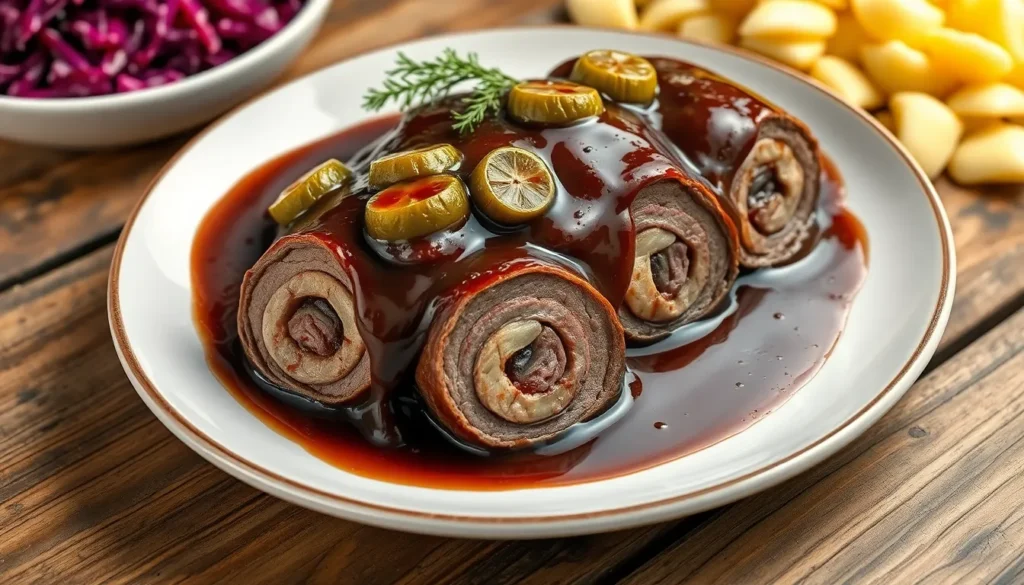We’re about to take you on a culinary journey to Germany with this authentic German Rouladen recipe that’ll transform your dinner table into a Bavarian feast. This traditional dish features tender beef rolls stuffed with savory filling and braised to perfection – it’s comfort food at its absolute finest.
Rouladen has been gracing German tables for centuries, originally created as a way to make tougher cuts of beef incredibly tender and flavorful. We love how this dish combines thin beef slices with a classic filling of onions, pickles, and mustard, then slow-cooks everything into fork-tender perfection.
What makes our German Rouladen recipe special is the rich, velvety gravy that develops during the braising process. We’ll show you how to achieve that restaurant-quality taste right in your own kitchen, using techniques passed down through generations of German cooks.
What Is German Rouladen
German Rouladen represents one of Germany’s most beloved traditional dishes featuring thin slices of beef rolled around a savory filling. We describe this classic comfort food as tender beef wrapped around a mixture of onions, pickles, mustard, and sometimes bacon or breadcrumbs. The rolled beef gets secured with toothpicks or kitchen twine before browning and braising in a rich gravy.
This hearty dish originated as a practical solution for making tougher cuts of beef more palatable and tender. German cooks discovered that pounding beef thin and slow cooking it in liquid transformed even the most challenging cuts into succulent, fork-tender meat. Rouladen typically uses top round or bottom round beef, which benefits from the extended braising process.
The filling creates the signature flavor profile that distinguishes authentic German Rouladen. We combine diced onions with dill pickles for tang, German mustard for depth, and often bacon bits for smokiness. Some regional variations include adding breadcrumbs or carrots to the filling mixture. Each household tends to have its own traditional combination passed down through generations.
Preparation involves pounding the beef slices to about ¼ inch thickness, spreading the mustard, adding the filling, then rolling tightly from one end to the other. The rolls get browned in a heavy pot to develop flavor before adding liquid for the braising process. This cooking method creates the rich, dark gravy that German families serve alongside the tender beef rolls.
Rouladen traditionally appears on German tables during Sunday dinners and special occasions. We often serve it with classic German sides like red cabbage, spaetzle, or boiled potatoes to soak up the flavorful gravy. The dish embodies the German cooking philosophy of transforming simple ingredients into something extraordinary through patience and proper technique.
Ingredients
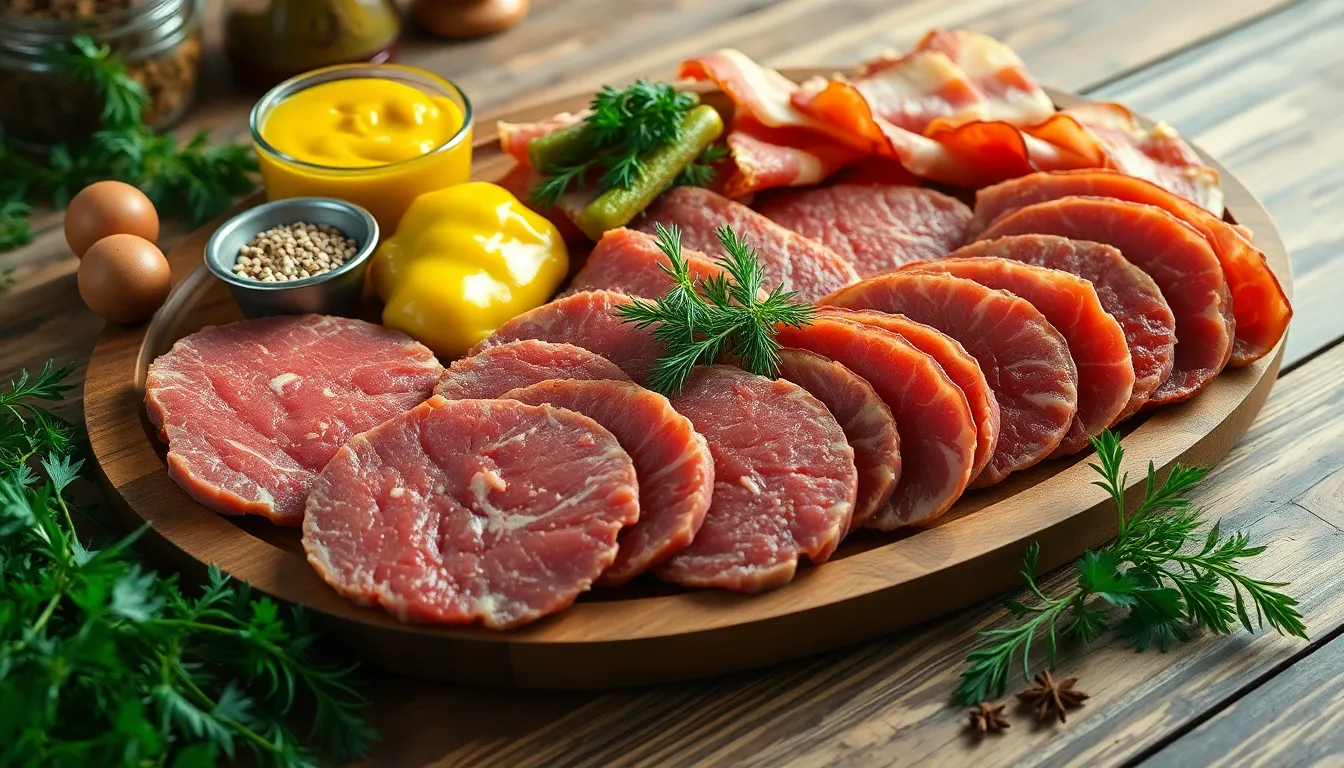
Creating authentic German Rouladen requires quality ingredients that work together to build layers of rich flavor. We’ve organized our ingredient list into three essential components to help you prepare this traditional dish with confidence.
For the Beef Rouladen
- 8 beef slices (top round or flank steak), cut 4×6 inches and ¼ inch thick
- Salt and freshly ground black pepper, to taste
- Toothpicks or kitchen twine for securing the rolls
For the Filling
- ⅓ cup German mustard (mild or Dijon style)
- 8 thin bacon slices (can be cut in half)
- 4 large dill pickles, sliced lengthwise
- 1 medium yellow onion, chopped or thinly sliced
For the Gravy
- 1 tablespoon butter (30 grams)
- 1 tablespoon cooking oil (avocado or neutral oil)
- 1 medium onion, chopped
- 1 medium carrot, chopped
- 1 stalk celery, chopped
- 1 leek, chopped (optional)
- 1 clove garlic, minced (optional)
- 1 cup dry red wine (375 ml)
- 2-4 cups strong beef broth or stock
- 1-3 tablespoons tomato paste
- 1 bay leaf
- Sugar, salt, and pepper to taste
- 1-2 tablespoons cornstarch mixed with water (for thickening)
- 75 ml pickle juice (optional, for extra tanginess)
Equipment Needed

Success with German Rouladen depends on having the right tools to properly prepare and cook this traditional dish. We’ve compiled a comprehensive list of essential equipment that will help you achieve restaurant-quality results at home.
Essential Preparation Tools
Meat Mallet serves as our most critical tool for transforming beef slices into the perfect rouladen base. We need to gently pound each slice to just under ¼ inch thickness without tearing the delicate meat fibers. A flat-sided mallet works best for achieving uniform thickness across each piece.
Sharp Knife and Cutting Board allow us to slice pickles, dice onions, and prepare vegetables with precision. Clean cuts ensure even cooking and prevent our filling ingredients from becoming mushy during the braising process.
Kitchen Twine or Toothpicks secure our carefully rolled rouladen so they maintain their shape throughout cooking. Wooden toothpicks work well for smaller rolls while kitchen twine provides better control for larger pieces.
Cooking Vessels
Dutch Oven stands as our preferred cooking vessel for authentic German Rouladen. Cast iron or enamel Dutch ovens distribute heat evenly and retain temperature perfectly for the slow braising process that makes tough beef incredibly tender.
Alternative cooking methods include pressure cookers, slow cookers, or Instant Pots for faster preparation times. These modern appliances can reduce cooking time while still achieving the fork-tender texture that defines excellent rouladen.
Measuring and Mixing Equipment
Measuring Cups and Spoons ensure accurate proportions of wine, broth, and seasonings for our rich gravy. Precision matters when building the complex flavors that make this dish exceptional.
Mixing Bowls organize our ingredients and help us prepare components efficiently. Having separate bowls for filling ingredients keeps our workspace organized and prevents cross-contamination of flavors.
Wooden Spoons stir our gravy without scratching cookware surfaces and help us scrape up flavorful browned bits from the bottom of our Dutch oven during the deglazing process.
Prep Instructions

Proper preparation forms the foundation of exceptional German Rouladen. We’ll guide you through each crucial step to ensure your beef rolls turn out perfectly tender and flavorful.
Preparing the Beef
We start by cutting our beef into approximately 3×4 inch rectangles using either flank steak or top round steak. Place each piece between plastic wrap or parchment paper and pound with a meat mallet until the thickness reaches about 1/4 inch. This technique enlarges the meat surface and breaks down tough fibers for optimal tenderness.
Lay the flattened beef slices on your work surface with the grain running horizontally. Spread 2 teaspoons of mild Dijon mustard evenly across each slice using the back of a spoon. Season both sides generously with salt and freshly ground black pepper to enhance the natural beef flavors.
Making the Filling
Place one strip of bacon lengthwise across each mustard-coated beef slice. The bacon should extend nearly to the edges but not overlap the sides. Distribute thin onion slices evenly over the bacon, ensuring they cover the surface without creating thick layers that could prevent proper rolling.
Add dill pickle chips on top of the onions, spacing them evenly across the beef surface. For enhanced flavor depth, we recommend sautéing finely chopped carrots, celery, and leeks with the onions beforehand. This additional step creates a richer filling base and contributes to a more complex gravy during the cooking process.
Rolling the Rouladen
Begin rolling from the narrow end of each beef slice, keeping the filling tightly packed as you work. Tuck the sides inward while rolling to prevent the filling from spilling out during cooking. Roll firmly but avoid applying excessive pressure that could tear the meat.
Secure each completed roll with 2-3 toothpicks placed at equal intervals, or tie with kitchen twine in 2-3 places. The securing method should hold the roll together without being too tight, as the meat will expand slightly during cooking. Pat each rouladen dry with paper towels before browning to achieve optimal color and flavor development.
Cooking Instructions
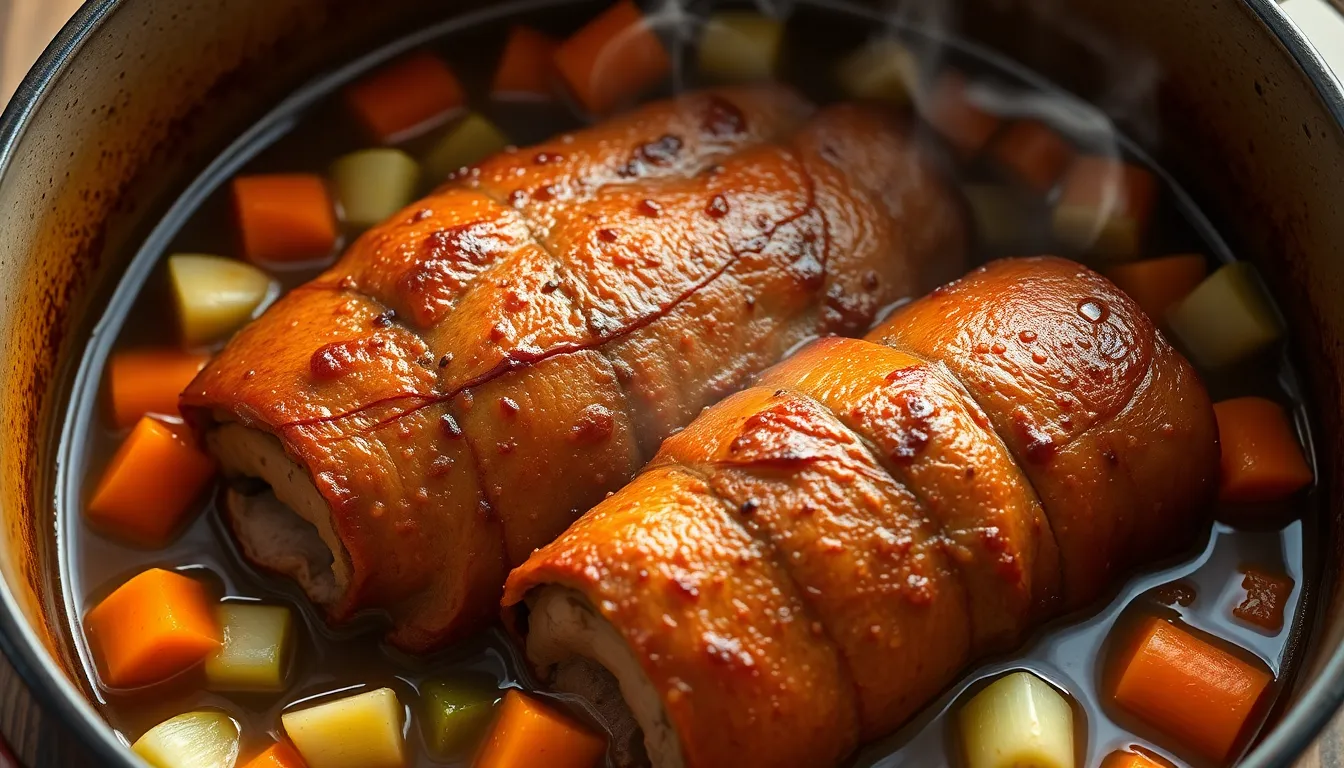
With our rouladen properly prepared and filled we can now transform these raw bundles into tender German delicacies. The cooking process involves three critical stages that build layers of flavor and ensure perfect texture.
Searing the Rouladen
We begin by heating our Dutch oven or heavy-bottomed pot over medium-high heat with a tablespoon of cooking oil. The oil should shimmer but not smoke when we add our first rouladen. We place each beef roll seam-side down first to help seal the edges then turn them carefully using tongs to brown all surfaces evenly. This searing process takes about 6-8 minutes total per batch as we want deep golden-brown color on each side.
Each rouladen should develop a rich caramelized crust that locks in the juices and creates fond on the bottom of our pot. We remove the browned rouladen to a plate and set them aside while we prepare the braising liquid. The browned bits left in the pot will become the foundation of our flavorful gravy.
Braising Process
We add our diced vegetables including carrots celery onions and leek directly to the same pot with the remaining drippings. These aromatics cook for about 3-4 minutes until they begin to soften and release their fragrance. We then pour in the dry red wine to deglaze the pan scraping up all those beautiful browned bits with a wooden spoon.
The beef stock goes in next followed by tomato paste if we choose to use it for extra depth. We nestle our seared rouladen back into the pot ensuring the liquid covers them about halfway. After bringing the mixture to a gentle simmer we cover the pot and transfer it to our preheated 325°F oven. The rouladen braise for approximately 90 minutes until they become fork-tender and easily pierced with a knife.
Making the Gravy
Once our rouladen reach perfect tenderness we carefully remove them from the braising liquid and tent with foil to keep warm. We strain the cooking liquid through a fine-mesh sieve into a clean saucepan removing the solid vegetables. For a rustic gravy we can puree these vegetables and return them to the liquid for added body and flavor.
We bring the strained liquid to a simmer over medium heat and create our thickening slurry by whisking flour or cornstarch with a small amount of cold water. We gradually whisk this mixture into the simmering liquid until our gravy reaches the desired consistency. For extra richness we stir in butter and a touch of heavy cream then season with salt pepper and a bit of German mustard to taste. Our finished rouladen return to this luscious gravy for a final warming before serving.
Serving Suggestions

We recommend pairing your German Rouladen with traditional sides that complement the rich, savory gravy and tender beef. Spätzle stands out as the quintessential accompaniment, with its soft egg noodle texture perfectly absorbing every drop of the flavorful braising liquid. These hand-pressed German dumplings create the ideal base for showcasing the complex flavors developed during our slow cooking process.
Potatoes offer another classic pairing that enhances the hearty nature of this dish. Mashed potatoes provide a creamy contrast to the robust beef, while boiled new potatoes maintain their shape and offer a subtle earthiness. We suggest preparing them simply with butter and fresh herbs to avoid competing with the rouladen’s bold flavors.
Red cabbage brings traditional German authenticity to your plate while adding vibrant color and tangy sweetness. The acidity cuts through the richness of the gravy, creating a balanced dining experience that honors the dish’s cultural heritage. Braised red cabbage with apples and onions particularly complements the pickled elements within the rouladen filling.
Braised greens such as kale or spinach provide nutritional balance and a slightly bitter note that enhances the overall flavor profile. These vegetables absorb the savory pan drippings beautifully while adding essential vitamins to the meal. We recommend sautéing them with garlic and a splash of the cooking liquid for maximum flavor integration.
German dark bread or crusty dinner rolls serve as excellent vehicles for soaking up any remaining gravy on your plate. The dense, hearty texture of traditional German bread varieties complements the substantial nature of the rouladen while ensuring no precious drop of sauce goes to waste.
Storage and Reheating Tips
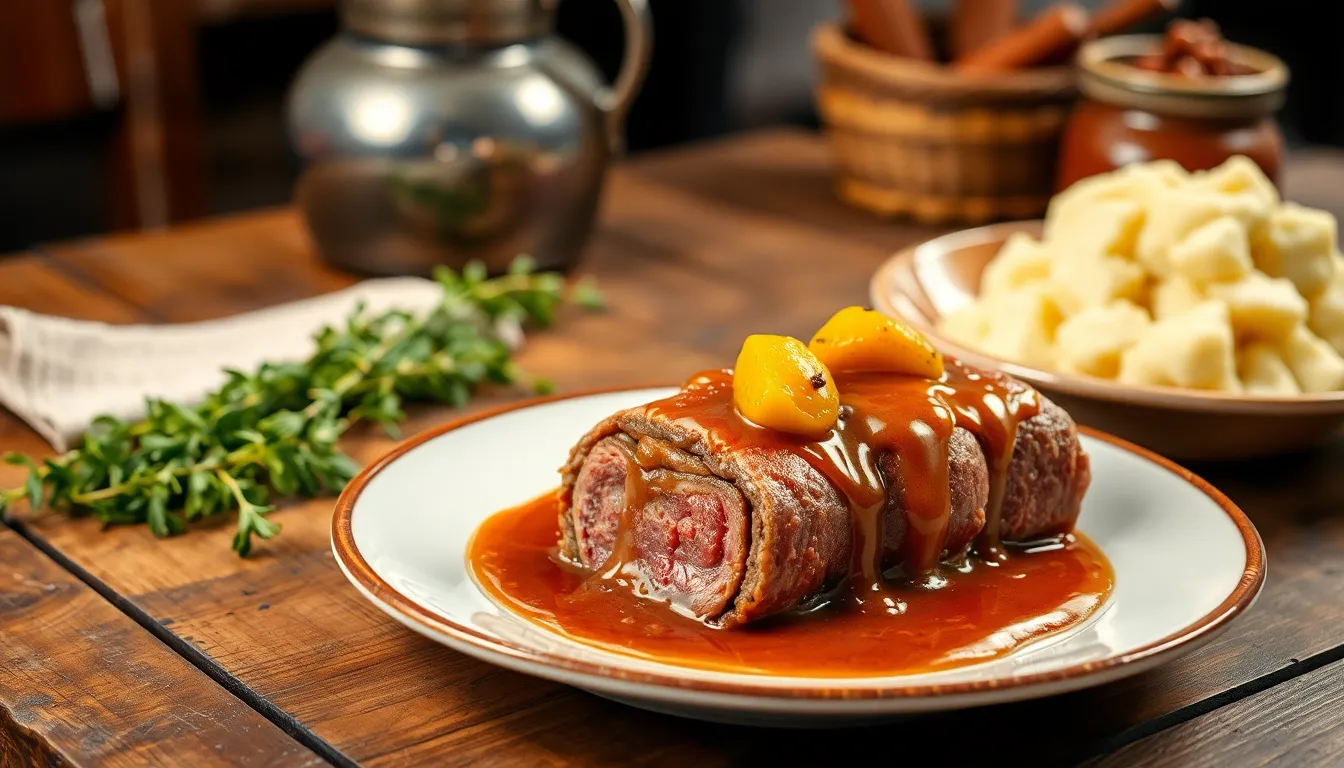
After you’ve savored this authentic German dish, proper storage techniques ensure your rouladen maintains its exceptional flavor and tender texture for days to come. We recommend cooling the rouladen and sauce completely before transferring them to storage containers, as this prevents condensation that could affect the meat’s quality.
Refrigerator Storage
Store your cooked rouladen in an airtight container in the refrigerator for optimal freshness. The beef rolls will maintain their quality for up to 3-4 days when properly stored. We always keep the rich gravy with the rouladen, as this prevents the meat from drying out and preserves the complex flavors that developed during braising.
| Storage Method | Duration | Container Type |
|---|---|---|
| Refrigerator | 3-4 days | Airtight container |
| Freezer | 2-3 months | Freezer-safe container |
Freezer Storage
For longer storage periods, freeze your rouladen with the sauce in freezer-safe containers for up to 2-3 months. We portion the rouladen into serving sizes before freezing, making it easier to thaw only what you need. Label containers with the date to track storage time and ensure you enjoy them at peak quality.
Gentle Reheating Methods
Reheat rouladen gently in a saucepan over low heat to preserve the meat’s tender texture. Add a splash of beef broth or water if the sauce appears too thick during reheating. We avoid high heat, which can cause the meat to become tough and the sauce to separate.
Microwave reheating works when you’re short on time, though we recommend covering the dish and using short intervals to maintain moisture. Check the rouladen frequently and add liquid as needed to prevent drying.
Flavor Enhancement Through Storage
When reheated properly, the flavors actually meld and intensify, creating an even more satisfying dish than when first prepared. The beef remains fork-tender, and the gravy develops deeper complexity as the ingredients continue to marry during storage.
Tips for Perfect German Rouladen
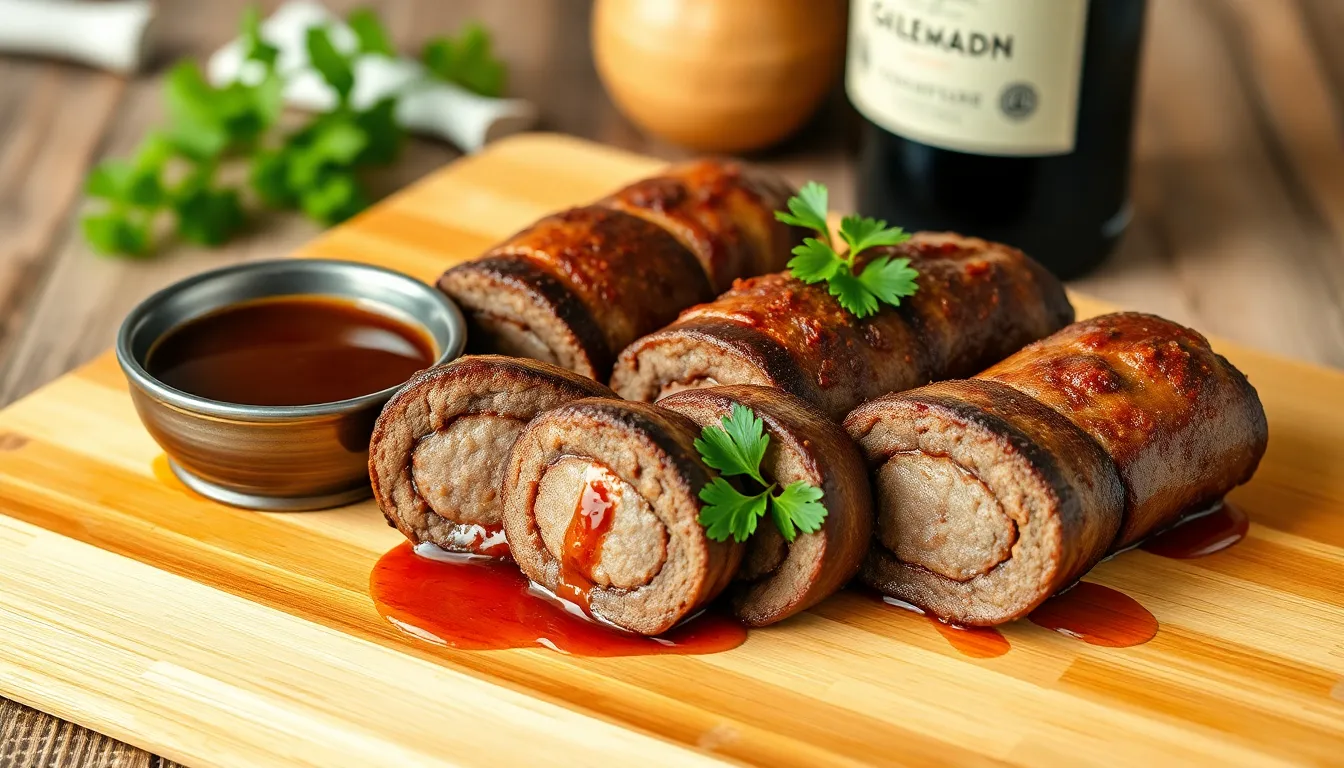
Achieving restaurant-quality German Rouladen requires mastering several key techniques that transform this traditional dish from good to exceptional. We’ve refined our approach through countless batches to bring you the most effective methods for success.
Select and prepare your beef properly for the foundation of great rouladen. We recommend using thin slices of top round or flank steak pounded to exactly ¼ inch thickness. The meat should be uniform to ensure even cooking throughout the braising process. Gentle pounding creates the ideal texture without tearing the delicate beef fibers.
Quality mustard makes all the difference in developing authentic German flavors. We always use genuine German mustard or high-quality Dijon mustard rather than standard yellow varieties. The mustard acts as both a flavor enhancer and moisture barrier that keeps the filling intact during the long cooking process.
Brown the rouladen thoroughly to create the rich foundation for your gravy. We never skip this crucial step because proper browning develops deep caramelized flavors and creates fond that becomes the backbone of the sauce. Each rouladen should achieve a golden-brown color on all sides before moving to the braising stage.
Secure your rolls tightly to prevent filling from escaping during cooking. We prefer kitchen twine over toothpicks because it provides more even pressure and won’t break under the pressure of braising. Tie the rouladen at both ends and once in the middle for optimal security.
Simmer low and slow for the most tender results possible. We maintain our braising liquid at a gentle simmer rather than a rolling boil to prevent the meat from becoming tough. The ideal cooking time ranges from 2 to 3 hours depending on the thickness of your beef slices.
Balance your braising liquid with the right combination of red wine and beef stock. We use approximately equal parts of each liquid to create depth without overwhelming the dish with alcohol. Adding pickle juice provides a subtle tang that brightens the rich gravy.
Don’t discard the browned bits from the bottom of your pot after searing. We deglaze thoroughly with red wine to capture every bit of caramelized flavor that will enrich our final sauce. These concentrated flavors separate amateur rouladen from professional-quality results.
Strain and thicken your gravy properly for a silky smooth finish. We remove all vegetable pieces and thicken with a cornstarch slurry rather than flour to avoid any lumpy texture. The gravy should coat the back of a spoon when properly thickened.
Conclusion
We’ve shared everything you need to master this beloved German comfort food that’ll transform your kitchen into a Bavarian restaurant. The combination of tender beef, savory filling, and rich gravy creates a meal that’s both satisfying and impressive.
The beauty of German Rouladen lies in its simplicity – basic ingredients elevated through proper technique and patience. Whether it’s your first attempt or you’re perfecting your family recipe, these methods will help you achieve that authentic taste.
Don’t forget that rouladen tastes even better the next day, making it perfect for meal prep or entertaining. Serve it with traditional sides like spätzle and red cabbage for the complete German dining experience that’ll have everyone asking for seconds.
Frequently Asked Questions
What is German Rouladen?
German Rouladen is a traditional comfort food consisting of thin beef slices rolled around a savory filling of onions, pickles, mustard, and sometimes bacon. The rolled beef is slow-cooked through braising, which transforms tough cuts into tender, fork-tender meat while creating a rich, flavorful gravy.
What cut of beef is best for Rouladen?
Top round or flank steak works best for German Rouladen. These cuts should be sliced thin and pounded to about ¼ inch thickness. While these are traditionally tougher cuts, the slow braising process transforms them into succulent, tender meat perfect for this dish.
How do you keep Rouladen rolls from falling apart?
Secure the rolled beef tightly with kitchen twine or toothpicks before cooking. Make sure to roll the beef firmly around the filling and tie or pin at regular intervals. This prevents the rolls from unraveling during the browning and braising process.
What are traditional sides served with German Rouladen?
Classic German sides include spätzle (soft egg noodles), mashed or boiled potatoes, red cabbage, and braised greens like kale or spinach. German dark bread or crusty rolls are also served to soak up the rich gravy. These sides complement the dish’s hearty, rich flavors.
How long does it take to cook German Rouladen?
German Rouladen requires slow cooking for optimal tenderness. After browning the rolls, they need to braise in liquid for approximately 1.5 to 2 hours on low heat. This slow cooking process ensures the beef becomes fork-tender and allows the rich gravy to develop properly.
Can German Rouladen be made ahead of time?
Yes, German Rouladen can be prepared in advance and actually improves in flavor when reheated. Store cooked rouladen and sauce in the refrigerator for 3-4 days or freeze for 2-3 months. Reheat gently to preserve the meat’s tenderness and rich flavors.
What type of mustard should I use for Rouladen?
German mustard is traditional and recommended for authentic flavor. However, Dijon mustard can be substituted if German mustard isn’t available. The mustard adds tanginess and helps bind the filling while complementing the other savory ingredients in the roll.
Why is my Rouladen tough?
Tough Rouladen usually results from insufficient cooking time or high heat. These dishes require low, slow braising to break down the meat fibers. Ensure you’re simmering gently for at least 1.5-2 hours and avoid boiling, which can make the meat tough and stringy.

